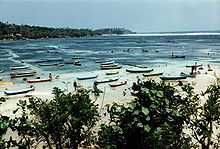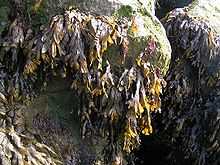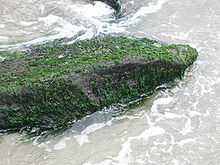Seaweed


Seaweed is a macroscopic, multicellular, marine algae that lives near the seabed (benthic).[1] The term includes some members of the red, brown, and green algae. Seaweeds can also be classified by use (as food, medicine,[2] fertilizer, filtration, industrial, etc.). The study of seaweed is known as Phycology.
Taxonomy
A seaweed may belong to one of several groups of multicellular algae: the red algae, green algae, and brown algae. As these three groups do not have a common multicellular ancestor, the seaweeds are a polyphyletic group. In addition, some tuft-forming bluegreen algae (Cyanobacteria) are sometimes considered to be seaweeds — "seaweed" is a colloquial term and lacks a formal definition.
Structure
Seaweeds' appearance somewhat resembles non-arboreal terrestrial plants.
- thallus: the algal body
- lamina or blade: a flattened structure that is somewhat leaf-like
- sorus: a spore cluster
- on Fucus, air bladder: a floatation-assisting organ on the blade
- on kelp, float: a floatation-assisting organ between the lamina and stipe
- stipe: a stem-like structure, may be absent
- holdfast: a specialized basal structure providing attachment to a surface, often a rock or another alga
- haptera: a finger-like extension of the holdfast anchoring to a benthic substrate
- lamina or blade: a flattened structure that is somewhat leaf-like
The stipe and blade are collectively known as the frond.
Ecology
Two specific environmental requirements dominate seaweed ecology. These are the presence of seawater (or at least brackish water) and the presence of light sufficient to drive photosynthesis. Another common requirement is a firm attachment point, although some genera such as Sargassum and Gracilaria have species that float freely. As a result, seaweeds most commonly inhabit the part of a sea that is close to the shore (the littoral zone) and within that zone more frequently on rocky shores than on sand or shingle. Seaweeds occupy a wide range of ecological niches. The highest elevation is only wetted by the tops of sea spray, the lowest is several meters deep. In some areas, littoral seaweeds can extend several miles out to sea. The limiting factor in such cases is sunlight availability. The deepest living seaweeds are some species of red algae.
Others have adapted to live in tidal rock pools. In this habitat seaweeds must withstand rapidly changing temperature and salinity and even occasional drying.[3]
Uses

Seaweed has a variety of purposes, for which it is farmed[4] or foraged from the wild.[5]
At the beginning of 2011, Indonesia produced 3 million tonnes of seaweed and surpassed the Philippines as the world's largest seaweed producer. By 2011 the production was to have hit 10 million tonnes.[6]
Food
Seaweeds are consumed by coastal people, particularly in East Asia, e.g. Brunei, Japan, China, Korea, Taiwan, Singapore, Thailand, Burma, Cambodia, and Vietnam, and also in South Africa, Indonesia, Malaysia, Belize, Peru, Chile, the Canadian Maritimes, Scandinavia, South West England,[7] Ireland, Wales, California, Philippines, and Scotland.
In Asia, Gim (Korean food) (김, Korea), nori (海苔, Japan), zicai (紫菜, China) are sheets of dried Porphyra used in soups or to wrap sushi. Chondrus crispus (commonly known as 'Irish moss' or carrageenan moss) is another red alga used in producing food additives, along with Kappaphycus and gigartinoid seaweeds. Porphyra is a red alga used in Wales to make laver. Laverbread, made from oats and the laver, is a popular dish there. In northern Belize, edible seaweeds are mixed with milk, nutmeg, cinnamon, and vanilla to make a common beverage affectionately called "dulce" (or "sweet").
Seaweeds are also harvested or cultivated for the extraction of alginate, agar and carrageenan, gelatinous substances collectively known as hydrocolloids or phycocolloids. Hydrocolloids have attained commercial significance as food additives.[8] The food industry exploits their gelling, water-retention, emulsifying and other physical properties. Agar is used in foods such as confectionery, meat and poultry products, desserts and beverages and moulded foods. Carrageenan is used in salad dressings and sauces, dietetic foods, and as a preservative in meat and fish products, dairy items and baked goods.
Herbalism


Alginates are commonly used in wound dressings, and production of dental moulds. In microbiology research, agar — a plant-based goo similar to gelatin and made from seaweed — is extensively used as culture medium. Carrageenans, alginates and agaroses (the latter are prepared from agar by purification), with other lesser-known macroalgal polysaccharides, have several important biological activities or applications in biomedicine.
Seaweed is a source of iodine,[9] necessary for thyroid function and to prevent goitre. Fucoidan concentrate in Limu Products[10]
Seaweed extract is used in some diet pills.[11][12][13] Other seaweed pills exploit the same effect as gastric banding, expanding in the stomach to make the body feel more full.[14][15]
Filtration
The strong photosynthesis of algae creates a large affinity for nutrients; this allows the seaweed to be used purposely to remove undesired nutrients from water. Nutrients such as ammonia, ammonium, nitrate, nitrite, phosphate, iron, copper, as well as CO2 are rapidly consumed by growing seaweed. Reefs and lakes are naturally filtered this way (the seaweed being consumed by fish and invertebrates), and this filtering process is duplicated in man-made seaweed filters such as algae scrubbers.[16]

Seaweed (macroalgae), as opposed to microalgae (phytoplankton), is used almost universally for filtration purposes because of the need to be able to easily remove (harvest) the algae from the water, which then removes the nutrients. Microalgae require more processing to separate it from the water than macroalgae does; macroalgae is simply pulled out.
When used for filtration, saltwater algae commonly grows species of Cladophora, Ulva, and Chaetomorpha. Freshwater filtration applications are useful, too, and will commonly grow species such as Spirogyra.
Other uses
Other seaweeds may be used as fertilizer, compost for landscaping, or a means of combating beach erosion through burial in beach dunes.[17] Seaweed is under consideration as a potential source of bioethanol.[18][19]
_algae_that_has_grown_in_an_algae_scrubber.jpg)
Seaweed is an ingredient in toothpaste, cosmetics and paints.[4] Alginates enjoy many of the same uses as carrageenan and are used in industrial products such as paper coatings, adhesives, dyes, gels, explosives and in processes such as paper sizing, textile printing, hydro-mulching and drilling. Research suggests that the Australian seaweed Delisea pulchra may interfere with bacterial colonization.[20] Sulfated saccharides from both red and green algae have been known to inhibit some DNA and RNA enveloped viruses.[2]
Health risks
Rotting seaweed is a potent source of hydrogen sulfide, a highly toxic gas, and has been implicated in some incidents of apparent hydrogen-sulphide poisoning.[21] It can cause vomiting and diarrhoea.
Genera
| Genus | Algae Phylum | Remarks | |
|---|---|---|---|
| Caulerpa | | Green | Under water |
| Fucus |  | Brown | In intertidal zones on rocky shores. |
| Gracilaria | | Red | Cultivated for food |
| Laminaria |  | Brown | Also known as kelp, 8–30 m under water, cultivated for food. |
| Macrocystis |  | Brown | Giant kelp, forming floating canopies. |
| Monostroma | Green | ||
| Porphyra |  | Red | Intertidal zones in temperate climate. Cultivated for food. |
See also

- Algaculture
- Algal fuel
- Aonori, Hijiki, Kombu, Mozuku, Nori, Ogonori, and Wakame - seaweed preparations used in Japan, and occasionally Korea and parts of Oceania
- Kelp
- Laver - seaweed prepared as food in Wales
- List of seaweeds of South Africa
- Sea lettuce
- Seaweed cultivator
- Seaweed dermatitis
- Silas Seaweed (mystery book series)
Further reading
- Christian Wiencke, Kai Bischof [editors]: Seaweed Biology: Novel Insights into Ecophysiology, Ecology & Utilization. Springer, 2012. ISBN 978-3-642-28450-2 (print); ISBN 978-3-642-28451-9 (eBook)
References
- ↑ Smith, G.M. 1944. Marine Algae of the Monterey Peninsula, California. Stanford Univ., 2nd Edition.
- ↑ 2.0 2.1 Kazłowski B, Chiu YH, Kazłowska K, Pan CL, Wu CJ (August 2012). "Prevention of Japanese encephalitis virus infections by low-degree-polymerisation sulfated saccharides from Gracilaria sp. and Monostroma nitidum". Food Chem 133 (3): 866–74. doi:10.1016/j.foodchem.2012.01.106.
- ↑ Lewis, J.R. 1964. The Ecology of Rocky Shores. The English Universities Press Ltd.
- ↑ 4.0 4.1 "Seaweed farmers get better prices if united". Sun.Star. 2008-06-19. Retrieved 2008-07-16.
- ↑ "Springtime's foraging treats". Life and Health. The Guardian. 2007-01-06. Retrieved 2008-07-16.
- ↑ "RI aims to become world`s largest seaweed producer". Waspada.co.id. 2011-04-16. Retrieved 2012-06-28.
- ↑ "Devon Family Friendly - Tasty Seaweed Recipe - Honest!". BBC. 2005-05-25. Retrieved 2012-06-28.
- ↑ Round F.E. 1962 The Biology of the Algae. Edward Arnold Ltd.
- ↑ "Iodine in Seaweed". January 10, 2015. Retrieved January 30, 2015.
- ↑ Template:Date=June 2012
- ↑ http://www.timesonline.co.uk/tol/life_and_style/food_and_drink/article2472720.ece
- ↑ Hayato Maeda, Masashi Hosokawa, Tokutake Sashima, Katsura Funayama & Kazuo Miyashita (2005). "Fucoxanthin from edible seaweed, Undaria pinnatifida, shows antiobesity effect through UCP1 expression in white adipose tissues". Biochemical and Biophysical Research Communications 332 (2): 392–397. doi:10.1016/j.bbrc.2005.05.002. PMID 15896707.
- ↑ http://www.dailymail.co.uk/health/article-1134430/So-diet-pills-CAN-trim-tum-Our-expert-brands-test.html?ITO=1490
- ↑ http://www.foxnews.com/story/0,2933,476766,00.html?sPage=fnc/health/nutrition
- ↑ http://news.softpedia.com/news/Appesat-the-Seaweed-Diet-Pill-that-Expands-in-the-Stomach-101227.shtml
- ↑ https://en.wikipedia.org/wiki/Algae scrubber
- ↑ Rodriguez, Ihosvani (April 11, 2012). "Seaweed invading South Florida beaches in large numbers". South Florida Sun-Sentinel. Retrieved 2012-04-11.
- ↑ Ireland Taps New Energy Source: Discovery News: Discovery Channel
- ↑ Seaweed Biofuels: Production of Biogas and Bioethanol from Brown Macroalgae
- ↑ Francesca Cappitelli & Claudia Sorlini (2008). "Microorganisms attack synthetic polymers in items representing our cultural heritage". Applied and Environmental Microbiology 74 (3): 564–569. doi:10.1128/AEM.01768-07. PMC 2227722. PMID 18065627.
- ↑ "Algues vertes: la famille du chauffeur décédé porte plainte contre X" AFP, retrieved 2010-04-22 (in French)
External links
| Wikimedia Commons has media related to Seaweed. |
- Michael Guiry's Seaweed Site, information on all aspects of algae, seaweeds and marine algal biology
- AlgaeBase, a searchable taxonomic, image, and utilization database of freshwater, marine and terrestrial algae, including seaweed.
- SeaweedAfrica, information on seaweed utilisation for the African continent.
- Seaweed. A chemical industry in Brittany, in the past and today.
- Sea Greens. An ingenious new business provides Maine’s lobster crews with a self-kelp manual for their downtime in winter. Portland Magazine, October 2013
- Seaweed Encyclopedia
- Seaweed For Dogs A range of articles on the benefits of including seaweed in the diet, with a focus on dogs.
